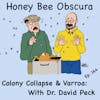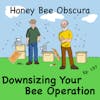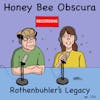Going Big Time - Large Observation Hives (059)

Managing large observation hives is very different than working with those small observation hives that you can take to a school or county fair. Very different indeed. Especially if you are going to keep this hive in your home or classroom. To begin,...
 Managing large observation hives is very different than working with those small observation hives that you can take to a school or county fair. Very different indeed. Especially if you are going to keep this hive in your home or classroom.
Managing large observation hives is very different than working with those small observation hives that you can take to a school or county fair. Very different indeed. Especially if you are going to keep this hive in your home or classroom.
To begin, there’s really no standard design. They can be a single frame wide or 2 or more frames wide. And how tall? Two, three frames tall? More than one frame wide and you’ll probably never see the queen, if only a single frame, the bees never get to cluster. So, do you cover them to help keep warm?
How do the bees get outside? Jim has a pretty good way figured out with a window for part of the year, but it’s not perfect. And how do you feed them? Syrup is pretty easy, protein not so much. And what about ventilation? Gotta have some, but not too much.
 And of course, varroa and small hive beetles will come visit, and probably decide to stay. Dealing with those pests can be a challenge no matter what hive, but here? And last, but not least, what about the smell? Sweet bees are a nice smell, but what about goldenrod honey? Or dead bees in winter? Figure that out before you start.
And of course, varroa and small hive beetles will come visit, and probably decide to stay. Dealing with those pests can be a challenge no matter what hive, but here? And last, but not least, what about the smell? Sweet bees are a nice smell, but what about goldenrod honey? Or dead bees in winter? Figure that out before you start.
___________________
We welcome Betterbee as sponsor of today's episode. BetterBee’s mission is to support every beekeeper with excellent customer  service, continued education and quality equipment. From their colorful and informative catalog to their support of beekeeper educational activities, including this podcast series, BetterBee truly is Beekeepers Serving Beekeepers. See for yourself at www.betterbee.com
service, continued education and quality equipment. From their colorful and informative catalog to their support of beekeeper educational activities, including this podcast series, BetterBee truly is Beekeepers Serving Beekeepers. See for yourself at www.betterbee.com
______________________
Honey Bee Obscura is brought to you by Growing Planet Media, LLC, the home of Beekeeping Today Podcast.
Music: Heart & Soul by Gyom, Walking in Paris by Studio Le Bus, original guitar music by Jeffrey Ott
Copyright © 2022 by Growing Planet Media, LLC

Episode 59 – Going Big Time - Large Observation Hives
[music]
Jim Tew: Kim, we recently talked about small observation hives and how enjoyable they are. I’d like to spend a few minutes talking about the big guys, the ones that live with you and how enjoyable they can be.
Kim Flottum: Yes, I’ve had those in the past. Never in my house but in the store. There’s a lot I am sure I don’t know, and a lot has changed since I did it. What do I need to know?
Jim: Yes, I want to talk about what little that I know. Hi, I’m Jim Tew.
Kim: I’m Kim Flottum.
Jim: We’re coming today from Honey Bee Obscura, where we want to talk about the big observation hives and sometimes the big problems they can bring.
Introduction: You are listening to Honey Bee Obscura. Brought to you by Growing Planet Media, the folks behind Bee Keeping Today Podcast. Each week on Honey Bee Obscura, host Kim Flottum and Jim Tew explore the complexities, the beauty, the fun, and the challenges of managing honey bees in today’s world and engaging an informative discussion meant for all bee keepers, long-timers, and those just starting their journey with bees. Sit back and enjoy the next several minutes, as Kim and Jim explore all things honey bees.
Jim: Right off the bat, Kim. I want to say that these big hives can be big problems and big successes, and that is all going to be your decision. There is no standard model I said that even with the small units. These things are always unique. The way you open them, the way you close them, the various features they have. None of them are standard. Some of them are furniture-grade, others are remarkably crude.
Kim: The one I had experience with was three deep frames, and that was it, one on top of the other. It was one frame wide, and three frames tall, but I’ve seen those that are three frames tall and 10 frames wide, sort of things, that big. If I’m going to have one in my house, I’m thinking probably three frames tall and two frames wide. Is that a good size, or is that not big enough, or too big?
Jim: No, you’re asking me like I’m some kind of authority. That’s certainly a common size. The things that, right now, some of the listeners are just chomping to say is that if you have double frames, or if you have inside combs and the queen is going to hide there, she’s going to preferentially stay there, and that’s true. If you’re goal every day is to see the queen, for whatever reason, then you don’t want those combs where they have an inside only one frame deep.
Then, other listeners, right now, are eager to say, “If you don’t have them at least two frames deep, then the bees can’t even form the semblance of a cluster, and they’re never going to be happy in that box. The reality is, they’re never going to be happy in that box anyway, even if you do have two frames, or three frames, side by side. A glass wall observation hive is not anything natural to them.
Anything you do is a tradeoff. I would be happy with two, two, and two, the way you just described, or even one, one, and one, depending on what you wanted to show.
Kim: Basic information, how close to the window does it need to be? How do I orchestrate the opening from the hive through the window so they can get in and out?
Jim: As always, miserable, Kim. When you say that, it’s just painful. When I put an observation hive, I had it put in, in my bee lab. We had to have the special people come in who could cut a hole through the infrastructure that held the safety glass in the wall. Then, later on, when they had observation hives put inside the building, they had to have people come in and physically bore holes through the wall.
This is a major undertaking to put these things in permanently, but more commonly, you’re going to put them in at a window. Then, you would raise the window slightly, put a board underneath that, drill a hole in the board, but then you got the window slightly raised up top. Basically, Kim, you do whatever you’re qualified to do, or you do whatever you can pay somebody else to do for you. Getting that entrance and exit may be a headache for you.
Kim: I’m thinking, I’m not going to drill through the window frame. I got all brand new windows, couple of years ago, and they are metal, and that’s not going to happen. The idea with the board makes sense. I could use that most of the year, but when it gets really cold in the winter, I’m going to have to do something else. Of course, when it’s cold in the winter, like it is right now, I’m looking at about 16 degrees and 14 inches of snow out here today. When I’m looking at that, your bees aren’t going to be outside anyway-
Jim: That’s right.
Kim: -so I could close it down, but they’re going to want to be outside the day after tomorrow when it gets up to 40.
Jim: Strange things happen, and I don’t know how the bees deal with it. How can they deal with it being 68 degrees inside and 16 degrees outside?
Kim: [laughs] We do it.
Jim: We do, but we control the thermostat. If you’re an animal, if you’re an insect, how do you set your thermometer? If it’s 16 degrees outside, it should almost be 16 degrees inside except for your cluster. Anyway, I don’t know. It’s one of the marvels of bees that somehow they figure out that there’s something weird going on here, but it’s very cold outside.
Kim: You bring up another question immediately. When we were talking about those small hives, you mentioned ventilation. I got six frames of bees in this glass box, how much ventilation do I need really, and can I over ventilate?
Jim: All right. This again is my experience with large observation hives, some that I’ve built, some that I’ve bought. I wanted a lot of ventilation. I had three deep frames on, three deep frames, on three deep frames. I had nine frames total, three, three, and three. Then, on the end, each one, I had a three-inch hole that I bored through the uprights, and then up top that were also three, three-inch holes, one was a feeder hole. I had major amounts of ventilation because I would want that much ventilation if I were a bee.
Kim, those bees went to work almost immediately propolizing those screens closed to the extent that I had to put the screens on the outside so I could take them off, melt the propolis off, and put it back on. Because I was convinced that the bees were going to, for lack of a better term, suffocate themselves inside this box chock-a-block full of bees, with no ventilation.
Kim: I can see, so you got to have something in the bottom to draw in fresh air and something at the top to expel the warm moist air, just sort of like a wintering hive.
Jim: One would think. Now, you’ve touched a nerve you didn’t mean to touch. If you move to the door of your house, and crack it open just a little bit, you can feel air either coming in or going out. I didn’t realize that when I put that observation hive in my bee lab. It drew, it siphoned, it pulled air from the outside, through the observation hive and vented it, and the bees were going crazy, trying to stop that, because they were living in this rush of air being drawn into the building by the heating and cooling system.
The way I’ve gotten around that was to make an eight-mesh tunnel that went in the entrance tube, so it would shunt that vacuum draw. Otherwise, I had this air flowing through, so when you said, “Air from the bottom, air from the top,” all those things were true, but it was not a gale force, but it was a lot of air being pulled through.
Kim: I’m thinking of bees in a tree. They’ve got an entrance usually on the bottom and nothing on top. I can see where it’s going to start getting complicated. One more thing that you got to think about, they’re not out foraging, or are they out foraging? Yes, they probably are, so what about feeding? Do you need a feeder? Most bees sometimes need feed. How did you organize that?
Jim: Yes, I always had feeders up top. You’d think it’s an observation hive, I’ll just open it. I’ll put a comb in. I’ll do whatever. Opening that hive is always a huge deal. When you’ve got three frames, three deeps, on three deeps, on three deeps, it’s got several thousand bees in there, when it’s really filled up. To open the thing, you would have bees that would come roaring out, out of-- the whole wall of the hive is open.
It was always much easier when they needed feeding just to feed them up top, so I’ve cut a hole that would take a typical jar feeder and I fed them up top as they needed it. I’d never found a good way in the one that I built to feed a protein substitute. I had almost no way to get it down. I tried to squeeze it through the hardware cloth, this is not working well. It was easy to feed syrup. I had a greater problem feeding a protein substitute.
Kim: I can see that. I’ve seen pictures of some that had a feeder right by the side of the box. You had to go underneath the feeder to get outside and you could put a jar on that or you could seal it in, you could put a cap on it and put some protein patty in, but the bees had to go right under it to get outside.
Better Bee: Betterbee is pleased to sponsor today’s episode of Honey Bee Obscura Podcast. For over 40 years, Betterbee has supplied beekeepers across the country with the tools, equipment, and knowledge needed to succeed. Because many Betterbee employees are beekeepers themselves, they understand your needs and challenges and are better prepared to answer your beekeeping questions. From their colorful catalog to their support of beekeeper educational activities, including this podcast, Betterbee truly lives up to their tagline of beekeepers serving beekeepers. See for yourself @betterbee.com.
Kim: How you do with Varroa?
Jim: I didn’t say that a bit ago when I was discussing the protein substitute, but it’s the same thing treating for Varroa if you’re going to build an observation hive. I built the one I’m talking about, there was no Varroa, but you need to build in some way for, I don’t know, whatever system you’re going to use, installing strips. If you’re using oxalic acids, some way to vaporize that.
Kim: Tricky.
Jim: You’ve got to work in some ways, or since you can open it up, you can do something dramatic. I guess, you can open them up, physically, take them out, it’s going to be miserable doing this Kim. This is a horrible idea. Put them in a deep hive body, take them three miles away, treat them for Varroa, bring them back three days later, and put them back in.
You must not have any other life, Kim. You got nothing else to do if you’re going to spend all this on trying to do this. You got to figure out some way to treat them or the reality of it, and my reality of this is, you think that they’re going to overwinter, you think nine frames is big enough to overwinter, it’s not practical.
Right around the first of November, you need to break that thing down and put it away. It’s going to get ugly. They’re going to have bees defecating inside the colony. You’re going to have an ugly partial death and a huge mess to clean up next spring in most cases. Just break it down.
Kim: You’ve got ahead of me a half a step here because you got a small, relatively weak population of bees and something that small hive beetle just loves to find. You’re probably going to have an issue with small hive beetle in there.
Jim: You do, you have an issue with everything in there. At least you can see your issues.
[laughter]
Kim: True.
Jim: If you stand there long enough, I do want to say this, I would stand there for hours, Kim and I wrote about it in Bee Culture, occasionally. What are these bees doing? I label these bees and one group of bees, stargazers. They would almost put their head flat up against the glass like they were looking up to the heavens if they were on a flat surface and they did nothing. They were figuratively standing there smoking a cigarette.
What are these bees doing that-- here’s one over here, here’s one over here. I have no idea what they were doing. Bees would jostle them and walk over them and they would not be dissuaded from their work. They were looking upwards.
Kim: Sound asleep.
Jim: I’d love to stand there watching what these bees were doing or trying to figure out what they were doing.
Kim: If I got one of these in my home and I’ve been watching them and I’ve been lucky, so far, I haven’t gotten Varroa or small hive beetle, just day to day, do I keep those glass sides covered? Do I open them up on special occasions or otherwise keep them covered on a sheet of styrofoam or something on the side so you got a little bit of insulation and it’s dark? Is that a good thing to do?
Jim: Everything you said I agree with, and that’s exactly what I did. I had a piece of styrofoam, one-inch styrofoam on each side and when I was not viewing it, I would close it all. No doubt, there was still a light getting at all the way around at the cracks, but at least it darkened it a lot. I did it for some insulation purposes, I did it for some darkness purposes. I wanted the queen to come out as much as possible to use those outside frames, just so I could watch what she was doing.
Kim: What happened after she laid that egg or those eggs, and the process of going-- you’ve handled feeding, and they can get outside so they’re foraging probably, so they’re supplying some of their own food, but if not, you’ve got a feeder set up. You’ve got pest control. You can see, and if you have to, you can take it out and treat or redo it.
You’ve got ways for them to get rid of dead bees from inside. Undertaker bees can carry them up. What else am I missing here that I need to be thinking about when I put one of these up in my living room?
Jim: I don’t know if you set me up for this or not, but there’s one thing I want to jump at. We all discuss that odor that bees make when they’re putting up honey in the fall coming in from aster and goldenrod, that strong pungent odor. If you’re living with a big observation hive in your house, they will move you out of your house. You can’t stay in the house when they’re bringing in that sweet stink from those fall asters and goldenrods. It’s stunning.
I have a nine-frame observation hive I’ve been describing behind this wall on an enclosed porch, and I can still smell that thing in my shop for about a month when they’re producing that honey. I’m thinking, I don’t know how you’d live with it. The air is just thick with that.
Whatever those bees are doing in your house, you’re going to be living with it. If they didn’t close those vent holes, you’re going to be living with bee hair and be parts and pollen and the odors that comes in with that, you’re living with a wild animal in your house. It needs to be a wild animal that you really want to live with.
Kim: We did a thing a while back on the smells of beekeeping, I’m going to have to go back and review that because one of them we did was good smells, and the other one we did was bad smells. Could I live with those bad smells going on in my house? I think maybe you’ve just changed my mind here.
Jim: I didn’t mean to change your mind. I’d put it in your garage. I’d put it out there near your chickens and then go stand there with a cup of coffee and look at the bees, and then they stay out there with your chickens and you go back in your house. You live near, but you don’t live with. There’s a difference. Keep them out of the sunlight. You got to put blinds up, whatever it takes. If the afternoon sun hits it, goes through the window, hits that observation hive, you’re going to kill your bees.
Kim: I bet I could put them in with the chickens. There’s a thought. I can take care of everything in one trip. Okay, there’s something to think about. Hey, this has been fun and I appreciate the information and I’m going to think more about this, but where and how and how big and all of those things, I got to wrestle with. I appreciate your help.
Jim: I’m happy to do it. I hope you consider getting an observation hive. Don’t let me talk to you out of it, but I really like them.
Kim: [laughs] Thanks. Catch you next time.
Jim: Bye-bye.
[00:18:49] [END OF AUDIO]
New to Honey Bee Obscura Podcast?
Here are some great episodes to start with. Or, check out episodes by topic.













